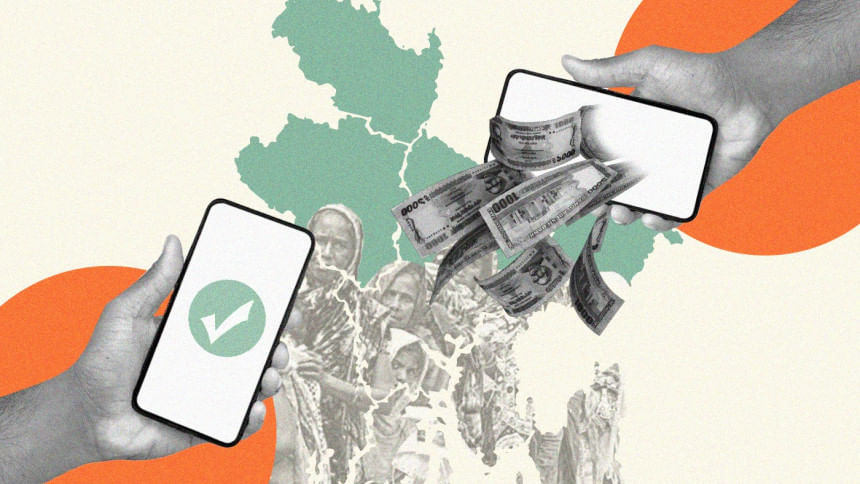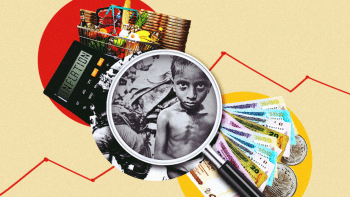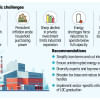Universal, not targeted, social protection is the path forward

The country's manufactured "miracle" tapestry, celebrated by the deposed regime and others in glowing terms, is fraying. The nation finds itself navigating a narrow ridge against the chasm of economic vulnerability. At the household level, the story is bleak. The World Bank's Macro Poverty Outlook projects that extreme poverty will rise from 7.7 percent to 9.3 percent in 2025 in Bangladesh. In plain terms, 30 lakh more Bangladeshis will be pushed below the poverty line within a single year. This is a devastating reckoning.
The Power and Participation Research Centre (PPRC)'s study titled the State of the Real Economy, commissioned by the Ministry of Finance, reveals that debt is crushing the poor. The bottom 40 percent of households owe at least double their savings. Underemployment affects 38 percent of workers. The economy is precarious for the labouring class, who sacrificed the most, including their lives, during the mass uprising in July-August last year, in pursuit of a better future.
The latest Labour Force Survey by the Bangladesh Bureau of Statistics (BBS) reveals a further setback for the youth, the front-runners of the July uprising. Youth unemployment has been rising steadily since 2016-17, reaching 13 lakh among those aged 15-24, followed by 9.16 lakh in the 25-34 age group and 3.79 lakh aged 35 or older in 2024. The plight is particularly severe for graduates, rising to nine lakh in 2024. One in three graduates cannot secure employment. The situation for the female workforce remains disheartening, accounting for 33.10 percent, while male workers constitute 66.90 percent of the employed population. Regionally, Dhaka Division has the highest number, with 687,000 unemployed individuals. The statistics should be interpreted with caution, as the definition may mask the true extent of unemployment.
This confluence of evidence exposes an inescapable truth. The existing social protection framework, a fragmented patchwork of targeted programmes, is fundamentally broken.
The current model's failure is not anecdotal. Its core mechanism is flawed, which perpetuates exclusion and wastes precious resources. The most damning fiasco is the exclusion error, with the intended beneficiaries left behind. The PPRC findings are shocking: the widow allowance reaches only 15.3 percent of eligible households. The Fair Price Card programme, a cornerstone of food security, deserts a staggering 94.7 percent, serving only 5.3 percent. Millions of the most destitute citizens are rendered invisible by a flawed targeting system, stripped off a lifeline when they need it most.
Inclusion errors are equally troubling. Benefits flow to those who do not need them. For example, a significant share of the Fair Price Card holders are non-poor. These "ghost" recipients syphon off scarce resources, weakening both efficiency and legitimacy.
The result is, thus, widening inequality. The Gini coefficient climbed from 0.334 in 2022 to 0.436 in 2025, placing Bangladesh among the most unequal societies. Targeted programmes, meant to close the gap, are instead deepening it. The recently held National Conference on Social Protection appropriately called for moving towards a universal protection system.
The case for universal, life-cycle social protection is an imperative. It is founded on the principle that social protection is a fundamental right of citizenship, not a form of charity.
A universal life-cycle system provides support at every stage of vulnerability. This framework could consist of certain pillars. For example, universal child benefits can ensure that every child receives adequate nutrition, given that two in three children under five in Bangladesh face food poverty. Second, universal education stipends can guarantee that no child drops out since almost 41 percent of the population aged between 5 and 24 years are not in educational institutions.
Third, for universal healthcare to function effectively, there is a need for a digital health card, an integrated referral platform and a digital logistics system to eliminate waste and inefficiency. Fourth, schemes such as unemployment insurance and maternity benefits could buffer the employment-seeking youth and people employed in unorganised sectors, including farming, cottage, small enterprises, and informal sectors.
Finally, an overarching requirement is a universal pension to ensure dignity for the elderly, a fast-ageing population of 1.5 crore people aged 60 and above.
The most common objection to universality is the cost. This approach, however, ignores the far greater cost of the status quo, particularly in view of the current predicament.
The government has already allocated Tk 116,731 crore to social protection in FY2025-26. The problem is not the size of the budget, but its inefficiency. On the fiscal front, reallocation of resources wasted on targeting errors and pursuing progressive fiscal measures is necessary.
A robust Digital Public Infrastructure (DPI), using the national ID (NID), can be a foundation for a unique identity system, integrated with a payment interface, creating "digital rails" for efficient delivery. Global experiences such as India's Aadhaar platform could help.
Simultaneously, at the national level, consolidation is vital. At present, multiple ministries run overlapping programmes, breeding duplication. A single social protection agency could harmonise delivery. Implementation can be gradually devolved to local governments. Proximity enhances accountability.
Universal, life-cycle social protection is an architecture of a resilient and just state. It forges a pathway where prosperity is shared. Hence, to protect the future of Bangladesh, universal social protection is the way forward.
Dr Rashed Al Mahmud Titumir is professor in the Department of Development Studies at the University of Dhaka.
Views expressed in this article are the authors' own.
Follow The Daily Star Opinion on Facebook for the latest opinions, commentaries and analyses by experts and professionals. To contribute your article or letter to The Daily Star Opinion, see our guidelines for submission.

 For all latest news, follow The Daily Star's Google News channel.
For all latest news, follow The Daily Star's Google News channel. 










Comments